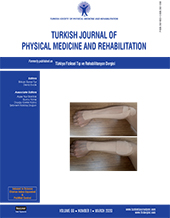Is there a relationship between venous insufficiency and knee osteoarthritis?
2 Department of Surgery, Division of Vascular Surgery, Ankara University School of Medicine, Ankara, Turkey
3 Department of Biostatistics, Ankara University School of Medicine, Ankara, Turkey DOI : 10.5606/tftrd.2020.5110 Objectives: This study aims to evaluate whether there is a relationship between venous insufficiency (VI) and knee osteoarthritis (OA).
Patients and methods: Between February 2012 and May 2013, a total of 206 knees of 103 participants (14 males, 89 females; mean age 48.6±8.6 years; range, 30 to 69 years) were enrolled. The study group included 59 patients who were diagnosed with knee OA and the control group included 44 healthy volunteers without any complaint in their knee joints. Demographic and clinical characteristics of all participants were recorded. Venous system of the lower extremities was evaluated by Doppler ultrasonography. All knees were evaluated using conventional radiography based on the Kellgren-Lawrence (K&L) grading system and ultrasonography. Pain severity was evaluated using Likert pain scale and functioning was evaluated using Western Ontorio and McMaster Universities Osteoarthritis Index (WOMAC).
Results: Venous insufficiency was detected in 40.6% of the OA group and 15.9% of the control group (p=0.007). There was no statistically significant difference in the cartilage thicknesses and K&L grading regarding the presence of VI (p>0.05); however, the percentage of the radiographic medial tibial sclerosis was higher in patients with VI (60%) in the OA group (p>0.05). The WOMAC total scores were similar in both groups, while the WOMAC pain scores were higher in the patients with deep VI (p>0.05).
Conclusion: Increased radiographic medial tibial sclerosis and higher WOMAC pain scores in patients with venous involvement in OA may lead to the hypothesis that venous system pathologies can affect the intraosseous microenvironment of the bone, resulting in pain and early subchondral bone involvement, consequently presenting as subchondral sclerosis.
Keywords : Cartilage, knee osteoarthritis, subchondral bone, venous insufficiency

















